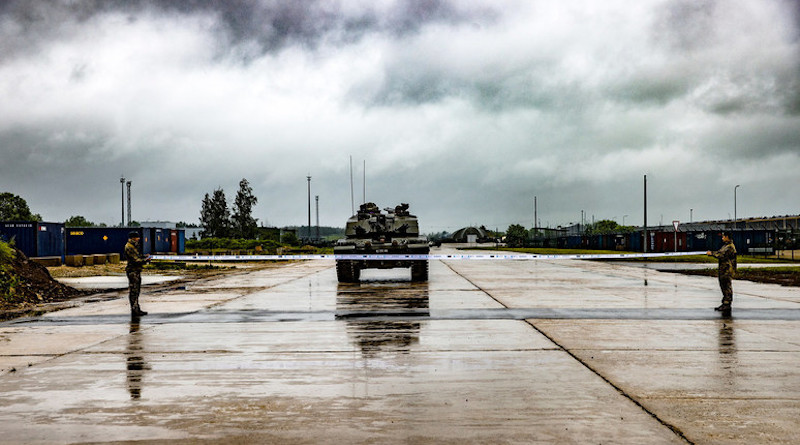With Nordics Set To Join NATO, Estonia Wants To Close Baltic Security Gaps
By EurActiv
By Alexandra Brzozowski
(EurActiv) — In Estonia, Finland and Sweden’s looming NATO accession is seen as a spectacular flop for Russia’s President Vladimir Putin and an opportunity to close gaps in Baltic Sea security.
Tapa, Estonia – At NATO’s Tapa military base in central Estonia, some soldiers have newly made, unofficial ‘Slava Ukraini‘ arm patches next to their own insignia, referring to the ‘Glory to Ukraine’ slogan used as a rallying cry, and more recently, a military salute.
Just a dozen kilometres from the Russian border, fears that Moscow’s forces could return have never gone away, also because the defence of the Baltics would be far more complex than that of Ukraine.
“The main existential threat for Estonia is just one-hour drive from here,” Colonel Andrus Merilo, who as head of Estonia’s first infantry brigade functions as NATO base commander, said.
“We have to deny the seizure and control of the territory – and that’s exactly what we are trained for,” he added.
After Russia invaded Georgia in 2008 and Ukraine in 2014, NATO decided to rotate troops throughout Estonia, Latvia, Lithuania and Poland into four so-called NATO multinational battlegroups of initially 1,000 troops per country.
The battalions are meant to buy time by resisting an attack while reinforcements arrive.
More (air) assets
But leaders in the region for long have argued that NATO should abandon its ‘tripwire’ posture in Eastern Europe and build up a permanent force capable of stopping a Russian offensive, as they fear Putin’s end goal lies beyond seizing Ukraine.
Estonia’s Prime Minister, Kaja Kallas, said on Thursday that NATO’s current proposals for reinforcing the defence of the Baltics were not enough.
“There are reasons to believe that Russia might attack NATO countries, and we need to be ready for this possibility,” Tuuli Duneton, Undersecretary for Defence Policy at the Estonian Ministry of Defence, told reporters in Tallinn.
“This is why we need to move from forward presence to forward defence,” Duneton said, adding this should include air defence systems, which Estonia is currently lacking, and which have proven crucial in defence of Ukraine.
The Baltic air policing mission should be upgraded to air defence, giving it the capacity to shoot down potential Russian incursions into the region’s airspace.
“NATO has currently an ongoing air policing mission, a peacetime mission, as all three Baltic countries are too small to dispose their own fighter aircraft and to conduct this mission specifically in our region,” she said.
“But we need a clear NATO allied air superiority in this region, and with a couple of fighter jets in the air policing mission, this cannot be guaranteed,” she added.
Nordic advantage
Estonian officials also believe that with Finland and Sweden’s looming accession to NATO, there is an opportunity to close strategic gaps in the Baltic Sea region.
Although NATO partners Helsinki and Stockholm have been part of an intensified exchange of information and NATO’s strategic communication since Russia invaded Ukraine, it was so far not possible to share other sensitive military information related to the region.
“With those two countries inside the alliance, air or maritime space in the region will become apparent space belonging to NATO – we will be stronger together against Russia,” Duneton stressed.
Baltic States have long worried about Finnish and Swedish islands in the Baltic Sea potentially being used as bases to attack them. The strategically located Swedish island of Gotland, for example, is crucial for the defence of Lithuania, Latvia, and Estonia.
Meanwhile, in Ukraine, Russia is conducting operations in the direction of the Black Sea port city of Odesa, targeting critical infrastructure, ports and junctions.
Finland and Sweden’s accession to NATO would mean significant new capabilities, Captain Johan-Elias Seljamaa, deputy commander of the Estonian Navy, told ETV on Thursday.
“Both countries’ armed forces have built up their naval fleets specifically for combat on the Baltic Sea,” Seljamaa said. “This will mean very specific capabilities that are surely very effective.”
Lessons learned from Ukraine
“The most important question is not about when and how Finland and Sweden will join NATO but as to why those nations have decided to join NATO,” Estonia’s NATO base commander, Merilo, told reporters.
“This is clear evidence that Russia is a threat not only for the Baltic States, for Poland anymore, but is also considered a real threat for Nordic security – this is a significant change in the security environment,” he said.
From the Russian perspective, this is exactly what they’ve been trying to avoid.
“Most likely they will do something at least to disrupt the joining process of Finland and Sweden or deploy forces close to their borders in the future, but it’s an illusion to think that the joining goes peacefully and Russia just sits there and waits,” Merilo said.
However, he thinks it’s unlikely Moscow would use nuclear weapons to deter such a step.
Asked whether he sees a weakening in the threat from the east since the Ukraine war started, Merilo said that Russian forces next to the Estonian border are “lower than normal”, but this does not mean Moscow could not restore them quickly.
“The truth is, the war in Ukraine has turned out to be more costly for the Russians, and they have to use the military forces which are most likely not intended to be used there,” he said.
“I don’t know from where they got the idea that Ukrainians will not fight back,” he added.
But one of the lessons learned from Ukraine is that “it is also key, especially for a small country like Estonia, how resilient a population is and how prepared it is for the large scale war,” Merilo said.
“This is why we train as we fight,” he added.

